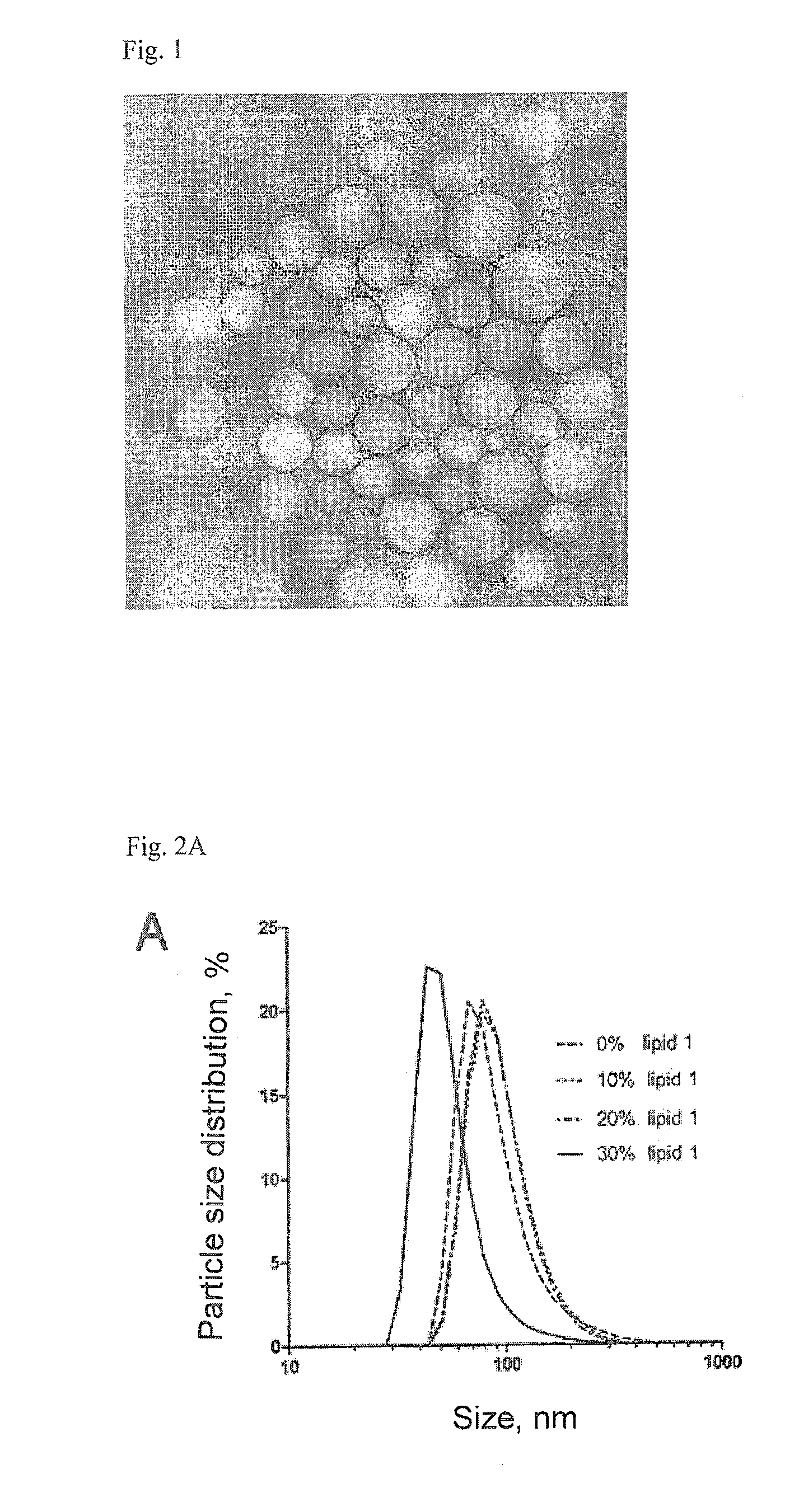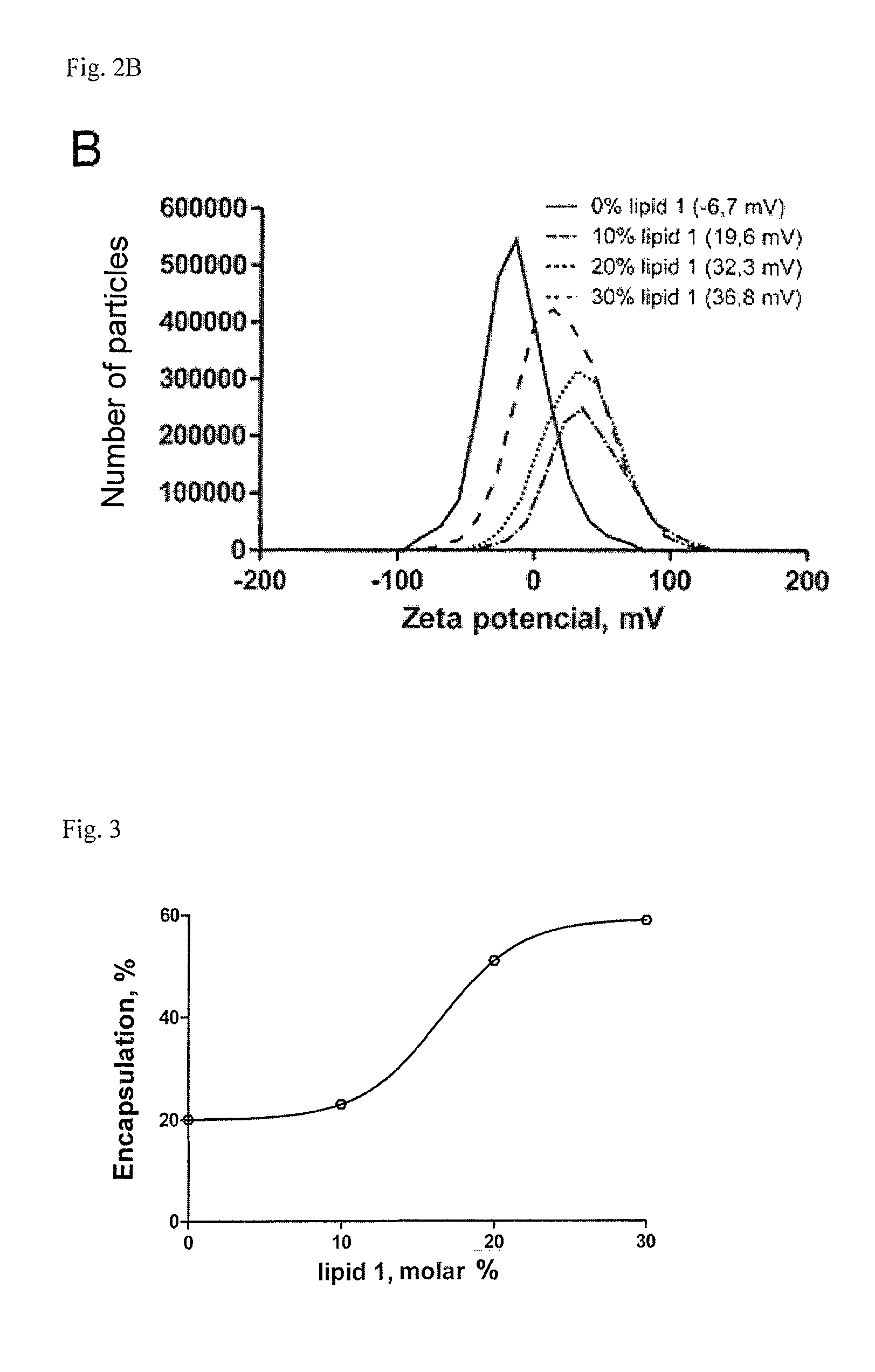Lipopolyamines of spermine type for construction of liposomal transfection systems
a technology of lipopolyamine and spermine, which is applied in the field of new lipopolyamines, can solve the problems of limited application of gene therapy and genetic vaccines into common clinical practice, insufficient transport efficiency of nucleic acid (na) fragments through cell walls and their subsequent internalization into the cell nucleus, and insufficient cell membrane transport efficiency. achieve the effect of limited stability of urethane linker
- Summary
- Abstract
- Description
- Claims
- Application Information
AI Technical Summary
Benefits of technology
Problems solved by technology
Method used
Image
Examples
example 1
[0059]To a stirred solution of 2-tetradecylhexadecanoic acid (formula VII where n5=13; 51.5 mg, 0.11 mmol) in dry N,N-dimethylformamide (4 mL), bis(pentafluorophenyl) carbonate (49 mg, 0.12 mmol) and 4-methylmorpholine (0.1 mL, 1 mmol) were added and the stirring was continued at room temperature for 1 h. The mixture was lyophilized from dioxane (2×20 mL), to give pentafluorophenyl ester of 2-tetradecylhexadecanoic acid (67 mg), which was immediately used at next condensation step.
[0060]A mixture of pentafluorophenyl ester of 2-tetradecylhexadecanoic acid and N2N3N4-tri-(tert-butoxycarbonyl)spermine (49 mg; 0.079 mmol) was dried in an apparatus equipped with septum for 4 h at room temperature and 0.1 Pa and then the apparatus was flushed with argon (2×). Dry N,N-dimethylformamide (4 ml) and N-ethyldiisopropylamine (0.5 ml) were added through the septum and the mixture was stirred at room temperature for 12 h. Flash chromatography of the crude reaction mixture on the silica gel colum...
example 2
[0061]To a solution of N1-(2-Tetradecylhexadecanoyl)-N4,N9,N12-tri-tert-butoxycarbonyl-1,12-diamino-4,9-diazadodecane (formula XI; X═C—N bond; Y=hydrophobic domain of the general formula V, where n5=13; 253 mg, 0.26 mmol) in dichloromethane (5 ml), trifluoroacetic acid (2 ml, 26 mmol) was added and the mixture was stirred at room temperature for 4 h. The mixture was evaporated in vacuo and the residue was lyophilized from dioxane (20 ml) to afford 171 mg of compound N1-(2-tetradecylhexadecanoyl)-1,12-diamino-4,9-diazadodecane (formula I; X═C—N bond; Y=hydrophobic domain of the general formula V, where n5=13). 1H NMR (400 MHz, Acetone-d6) δ (ppm): 3.98 t, J=6.25 Hz, 2H (CH2-2); 3.36 t, J=6.13 Hz, 2H (CH2-6); 3.27-3.32 m, 2H (CH2-9); 3.13-3.21 m, 6H (CH2-11, CH2-4); 3.10 t, J=6.63 Hz, 2H (CH2-13); 2.31-2.38 m, 1H (CH-2′); 1.93-2.03 m, 6H (CH2-3, CH2-7, CH2-8); 1.53-1.62 m, 2H (CH2-12); 1.35-1.43 m, 4H (CH2-3′, CH2-1″); 1.28 s, 36H (CH24′-16′, CH21-13″); 0.88 t, J=7.00 Hz, 6H (CH2-17′,...
example 3
[0062]To a stirred solution of N-(2-Tetradecylhexadecanoyl)-15-amino-4,7,10,13-tetraoxapentadecanoic acid (general formula VIII; where n1=3 and n5=13; 206 mg, 0.29 mmol) in dry N,N-dimethylformamide (10 ml), bis(pentafluorophenyl) carbonate (128 mg, 0.32 mmol) and 4-methylmorpholine (0.25 ml, 2.45 mmol) were added and the stirring was continued at room temperature for 1 h. The reaction mixture was lyophilized from dioxane (2×20 ml) to give pentafluorophenyl ester of N-(2-Tetradecylhexadecanoyl)-15-amino-4,7,10,13-tetraoxapentadecanoic acid (251 mg), which was immediately used at the next condensation step.
[0063]The mixture of pentafluorophenyl ester of N-(2-Tetradecylhexadecanoyl)-15-amino-4,7,10,13-tetraoxapentadecanoic acid (181 mg; 0.21 mmol) and N2N3N4-tri-(tert-butyloxycarbonyl)spermine (105 mg, 0.2 mmol) was dried in an apparatus equipped with septum for 4 h at room temperature and 0.1 Pa and then the apparatus was flushed with argon (2×). Dry N,N-dimethylformamide (8 ml) and ...
PUM
| Property | Measurement | Unit |
|---|---|---|
| concentrations | aaaaa | aaaaa |
| concentration | aaaaa | aaaaa |
| hydrophobic | aaaaa | aaaaa |
Abstract
Description
Claims
Application Information
 Login to View More
Login to View More - R&D
- Intellectual Property
- Life Sciences
- Materials
- Tech Scout
- Unparalleled Data Quality
- Higher Quality Content
- 60% Fewer Hallucinations
Browse by: Latest US Patents, China's latest patents, Technical Efficacy Thesaurus, Application Domain, Technology Topic, Popular Technical Reports.
© 2025 PatSnap. All rights reserved.Legal|Privacy policy|Modern Slavery Act Transparency Statement|Sitemap|About US| Contact US: help@patsnap.com



